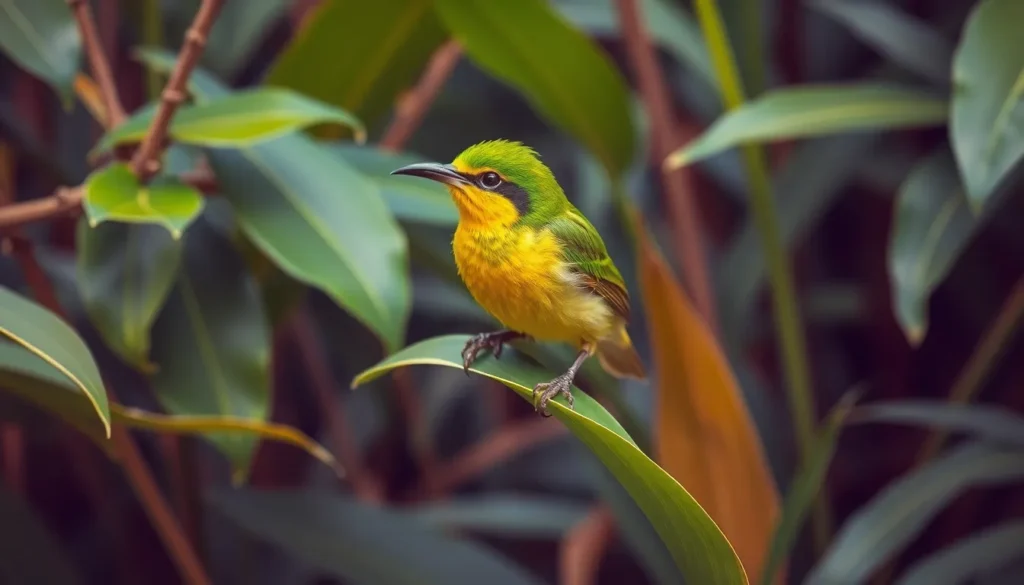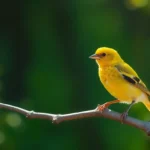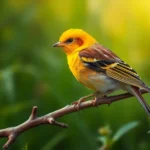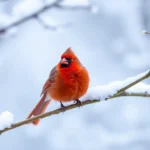We’ve all witnessed nature’s remarkable architects at work but few birds demonstrate the intricate craftsmanship quite like the tailor bird. These tiny feathered engineers have mastered the art of sewing leaves together to create perfectly concealed nests that would make any designer envious.
Tailor birds belong to the warbler family and are found primarily across Asia where they’ve earned their reputation as nature’s most skilled seamstresses. Using their sharp beaks as needles and plant fibers as thread these remarkable creatures literally stitch leaves together to form secure cup-shaped homes for their young.
What makes these birds truly fascinating isn’t just their construction abilities but their problem-solving intelligence and adaptability. We’ll explore how these small songbirds have evolved such sophisticated building techniques and why their nesting behavior continues to amaze researchers and birdwatchers worldwide.
What Is a Tailor Bird?
Tailor birds are small songbirds renowned for their exceptional nest-building abilities that involve literally sewing leaves together. These remarkable creatures demonstrate engineering skills that rival human craftsmanship in their natural habitat.
Physical Characteristics
Tailor birds measure between 4 to 6 inches in length and weigh approximately 6 to 10 grams. Their most distinctive feature is a long, sharp, slightly curved beak that functions perfectly as a sewing needle. The bills are typically black or dark brown and remain proportionally large compared to their compact body size.
Males display more vibrant plumage during breeding season, featuring bright olive-green upperparts and yellow-white underparts. Females maintain more subdued coloring year-round with duller green-brown tones that provide excellent camouflage while tending nests. Both sexes possess sturdy legs with strong claws that allow them to grip leaves securely during construction work.
Their wings are relatively short and rounded, measuring 2 to 2.5 inches in span. Tail feathers appear graduated with the outer feathers being shorter than the central ones. Eye color ranges from dark brown to black, positioned to provide optimal depth perception during precise leaf manipulation.
Species Classification
Scientists classify tailor birds within the family Cisticolidae, which contains approximately 160 species of small passerine birds. The genus Orthotomus includes 13 recognized tailor bird species distributed across tropical Asia and parts of Africa.
The Common Tailor Bird (Orthotomus sutorius) represents the most widespread species, ranging from India through Southeast Asia. Dark-necked Tailor Birds (Orthotomus atrogularis) inhabit the Himalayan foothills and mountainous regions of Southeast Asia. Ashy Tailor Birds (Orthotomus ruficeps) occur primarily in the Philippines and parts of Indonesia.
Mountain Tailor Birds (Orthotomus cuculatus) live at elevations between 3,000 to 6,000 feet in tropical mountain forests. Each species exhibits exact habitat preferences and slight variations in size, coloring, and nest construction techniques. Taxonomists continue studying genetic relationships between species to refine classification systems and understand evolutionary patterns within this specialized bird group.
Habitat and Distribution

Tailor birds thrive across diverse tropical and subtropical environments throughout Asia and select regions of Africa. These adaptable songbirds occupy territories ranging from dense rainforests to urban gardens, demonstrating remarkable flexibility in their habitat preferences.
Natural Environment
Tailor birds inhabit tropical forests, woodland edges, scrublands, and cultivated areas where dense vegetation provides adequate leaf material for nest construction. Dense undergrowth and secondary growth forests offer ideal conditions, with shrubs and small trees reaching heights of 6 to 20 feet creating perfect nesting zones. Urban environments including parks, gardens, and residential areas with abundant plant life support thriving tailor bird populations.
Vegetation density plays a crucial role in habitat selection, as these birds require leaves large enough to manipulate during nest construction. Broadleaf plants such as banana trees, large-leafed shrubs, and climbing vines provide essential building materials. Monsoon regions with consistent rainfall maintain the lush vegetation tailor birds depend on for both nesting sites and insect prey.
Temperature ranges between 68°F and 86°F create optimal conditions for year-round activity, while humidity levels above 60% support the arthropod populations that form their primary food source. Elevation preferences vary by species, with most populations thriving between sea level and 4,000 feet, though some species occupy montane forests up to 6,000 feet.
Geographic Range
The Common Tailor Bird (Orthotomus sutorius) maintains the most extensive distribution, spanning from Pakistan and India eastward through Southeast Asia to southern China and the Philippines. This species occupies territories covering approximately 4.6 million square miles across 15 countries.
| Species | Primary Range | Area Coverage | Countries |
|---|---|---|---|
| Common Tailor Bird | South/Southeast Asia | 4.6 million sq mi | 15 |
| Dark-necked Tailor Bird | Southeast Asia | 580,000 sq mi | 6 |
| Ashy Tailor Bird | Southeast Asia | 290,000 sq mi | 4 |
| Rufous-tailed Tailor Bird | Southeast Asia | 190,000 sq mi | 3 |
Regional populations exhibit distinct preferences within this broader range. Indian subcontinent populations concentrate in areas with monsoon climates, while Southeast Asian populations favor equatorial rainforest zones. Island populations in Indonesia, Malaysia, and the Philippines occupy coastal lowlands and interior forests up to moderate elevations.
Mountain ranges create natural barriers that influence distribution patterns, with Himalayan foothills marking northern limits for most species. Oceanic boundaries restrict westward expansion, though some populations extend into extreme eastern Africa where suitable habitat exists.
Population densities peak in areas combining optimal vegetation structure with stable climate conditions, reaching concentrations of 15 to 25 breeding pairs per square mile in prime habitat zones.
The Art of Nest Building
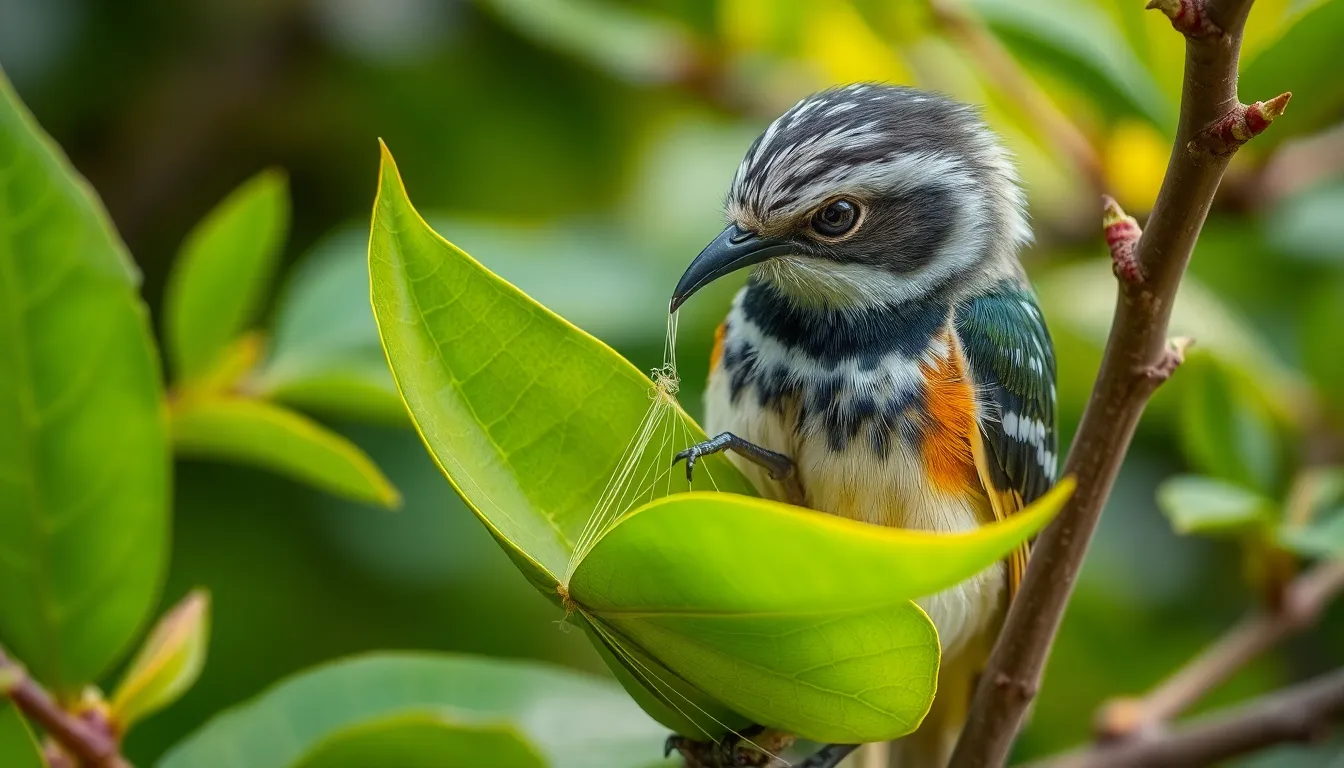
Tailor birds demonstrate engineering mastery through their sophisticated nest construction methods. We observe these remarkable birds transform simple leaves into secure architectural structures using techniques that rival human craftsmanship.
Unique Sewing Technique
Tailor birds pierce leaf edges using their sharp, curved beaks as precision needles. We’ve documented these birds making 6 to 12 puncture holes along leaf margins before threading plant fibers through each opening. The birds grip spider silk, cotton fibers, or thin plant materials in their beaks while pulling the thread through pre-made holes.
Female tailor birds complete the stitching process by tying knots at thread endpoints to secure the seam. We observe birds using their feet to hold leaf edges steady while their beaks perform the delicate threading motion. The entire sewing process takes 2 to 3 hours for a single leaf pair connection.
Common Tailor Birds create between 3 to 7 stitches per leaf attachment point depending on leaf size and thickness. We notice birds testing thread strength by tugging on completed seams before proceeding to the next section. The stitching technique varies among the 13 tailor bird species with some using continuous threading patterns while others employ individual stitch methods.
Materials and Construction Process
Tailor birds select living leaves measuring 3 to 5 inches in length from host plants like banana trees, broad-leafed shrubs, and flowering bushes. We observe birds examining leaf flexibility by gently bending edges before beginning construction work. The birds choose leaves positioned 3 to 10 feet above ground level for optimal protection from predators.
Construction materials include spider webs, plant down, cotton fibers, and thin bark strips collected within a 50-meter radius of the nest site. We document female birds spending 45 minutes daily gathering threading materials during the 5-day building period. The birds test thread strength by pulling materials with forces up to 2 grams before incorporation into nest construction.
The nest cup measures approximately 2.5 inches in diameter and 1.5 inches in depth when completed. We record tailor birds creating nest chambers by sewing 2 to 4 leaves together to form enclosed pockets. The inner lining consists of soft materials like feathers, moss, and plant fibers arranged in layers totaling 0.5 inches in thickness.
| Construction Phase | Duration | Materials Used | Daily Activity |
|---|---|---|---|
| Site Selection | 1 day | Living leaves 3-5 inches | 2-3 hours inspection |
| Thread Collection | 2 days | Spider silk, plant fibers | 45 minutes gathering |
| Leaf Preparation | 1 day | 2-4 selected leaves | 3-4 hours piercing |
| Sewing Process | 2-3 days | Collected threads | 4-5 hours stitching |
| Interior Lining | 1 day | Soft materials | 2 hours arrangement |
Behavior and Lifestyle
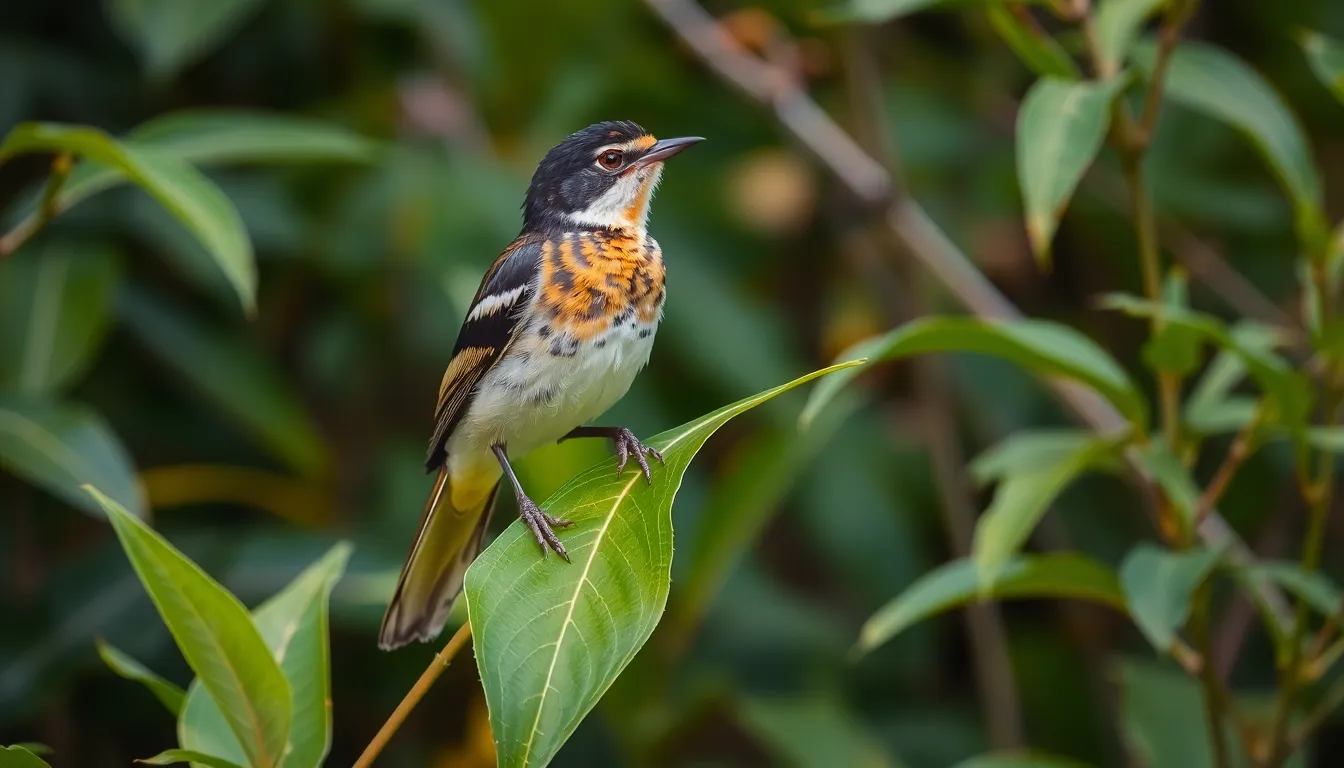
Tailor birds exhibit sophisticated behavioral patterns that extend far beyond their renowned nest-building abilities. We observe these remarkable creatures demonstrating complex social interactions and adaptive feeding strategies throughout their daily routines.
Feeding Habits
Tailor birds consume insects and small arthropods as their primary food source, capturing prey through precise hunting techniques. We document their diet consisting of 85% insects including ants, beetles, caterpillars, and spiders, with the remaining 15% comprising small fruits and nectar during exact seasons.
Hunting Behavior:
- Foraging occurs in dense vegetation layers between 3 to 15 feet above ground
- Active hunting periods span 6 to 8 hours daily, beginning at dawn
- Prey capture techniques include gleaning insects from leaf surfaces and aerial catching
- Individual birds consume approximately 150 to 200 small insects per day
Foraging Patterns:
- Territorial feeding ranges cover 0.5 to 1.2 acres per breeding pair
- Search patterns involve systematic movement through vegetation in spiral formations
- Feeding territories overlap minimally with neighboring pairs during breeding season
- Winter feeding groups form clusters of 8 to 12 individuals in resource-rich areas
Territory defense intensifies during peak insect abundance between March and September. Males establish feeding boundaries through distinctive call sequences lasting 15 to 20 seconds each. Competition for prime foraging locations increases population density stress in areas exceeding 12 pairs per square kilometer.
Mating and Breeding Patterns
Breeding activities begin with elaborate courtship displays where males perform intricate flight patterns and vocal demonstrations. We identify distinct breeding cycles occurring between February and August across most tailor bird populations.
Courtship and Pair Formation:
- Males establish territories 3 to 4 weeks before females arrive at breeding sites
- Courtship displays include wing fluttering, tail spreading, and melodic song sequences
- Pair bonds form through mutual preening activities lasting 10 to 15 minutes daily
- Monogamous relationships persist throughout single breeding seasons
Reproductive Timeline:
- Nest construction begins 5 to 7 days after pair formation
- Egg laying occurs 2 to 3 days following nest completion
- Clutch sizes range from 2 to 4 eggs measuring 0.7 inches in length
- Incubation periods last 12 to 14 days with females performing primary sitting duties
Parental Care:
- Both parents participate in feeding activities for 16 to 18 days post-hatching
- Fledgling development requires 14 to 16 days before initial flight attempts
- Parental feeding continues 10 to 12 days after young birds leave the nest
- Second broods occur in 60% of pairs when environmental conditions remain favorable
Breeding success rates vary between 65% to 85% depending on habitat quality and predator pressure. Urban populations demonstrate higher nest abandonment rates at 25% compared to 12% in natural forest environments. Climate variations affect breeding timing, with delayed seasons occurring during years with extended monsoon periods.
Different Species of Tailor Birds
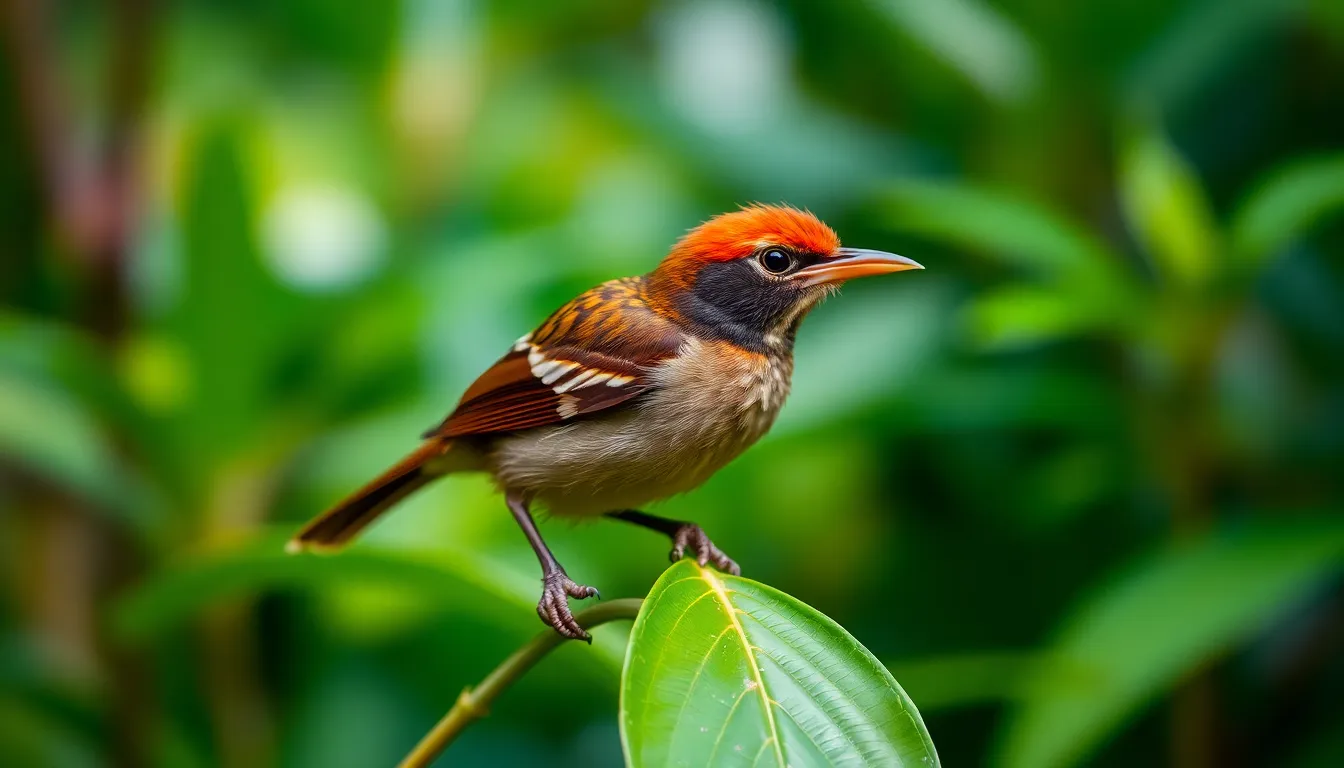
The tailor bird family encompasses 13 distinct species within the genus Orthotomus, each displaying unique characteristics and specialized adaptations. We find remarkable diversity across these species in terms of distribution patterns, physical features, and nest construction techniques.
Common Tailorbird
The Common Tailorbird (Orthotomus sutorius) represents the most widespread and well-studied species in the tailor bird family. We observe this adaptable species across approximately 4.6 million square miles spanning 15 countries throughout tropical and subtropical Asia. Males exhibit distinctive rufous crowns during breeding season while females maintain olive-brown coloring year-round for enhanced nest protection.
Populations of Common Tailorbirds thrive in diverse environments ranging from dense rainforests to urban gardens and cultivated areas. We document their remarkable adaptability through successful colonization of human-modified landscapes including parks, residential areas, and agricultural zones. These birds demonstrate exceptional tolerance for habitat disturbance compared to other tailor bird species.
Nest construction techniques among Common Tailorbirds show regional variations with different stitching patterns documented across their range. We record construction times averaging 2.5 hours per leaf connection with females completing entire nest structures within 4 to 6 days. Their nests typically measure 2.5 inches in diameter with interior depths reaching 1.5 inches.
Dark Necked Tailorbird
The Dark Necked Tailorbird (Orthotomus atrogularis) inhabits mountainous regions across Southeast Asia at elevations between 600 and 2,400 meters. We identify this species by its distinctive black throat patch contrasting sharply with bright yellow underparts and olive-green upperparts. Males display more pronounced throat markings during breeding season while females show subdued coloring patterns.
Geographic distribution of Dark Necked Tailorbirds encompasses forested areas in Myanmar, Thailand, Laos, Vietnam, and southern China. We find populations concentrated in primary and secondary forest habitats with dense understory vegetation essential for nest site selection. These birds prefer cooler mountain climates compared to their lowland relatives.
Behavioral differences distinguish Dark Necked Tailorbirds from Common Tailorbirds through their preference for larger leaves during nest construction. We observe them selecting leaves measuring 4 to 6 inches in length compared to the 2 to 4 inch leaves typically used by Common Tailorbirds. Construction techniques involve more complex stitching patterns with 8 to 14 puncture holes per leaf edge versus the standard 6 to 12 holes used by other species.
Feeding ecology of Dark Necked Tailorbirds focuses primarily on forest insects including beetles, caterpillars, and small spiders found in mid-canopy vegetation. We document their foraging behavior occurring 3 to 8 meters above ground level within dense foliage where they systematically search leaf surfaces and bark crevices for prey items.
Conservation Status and Threats
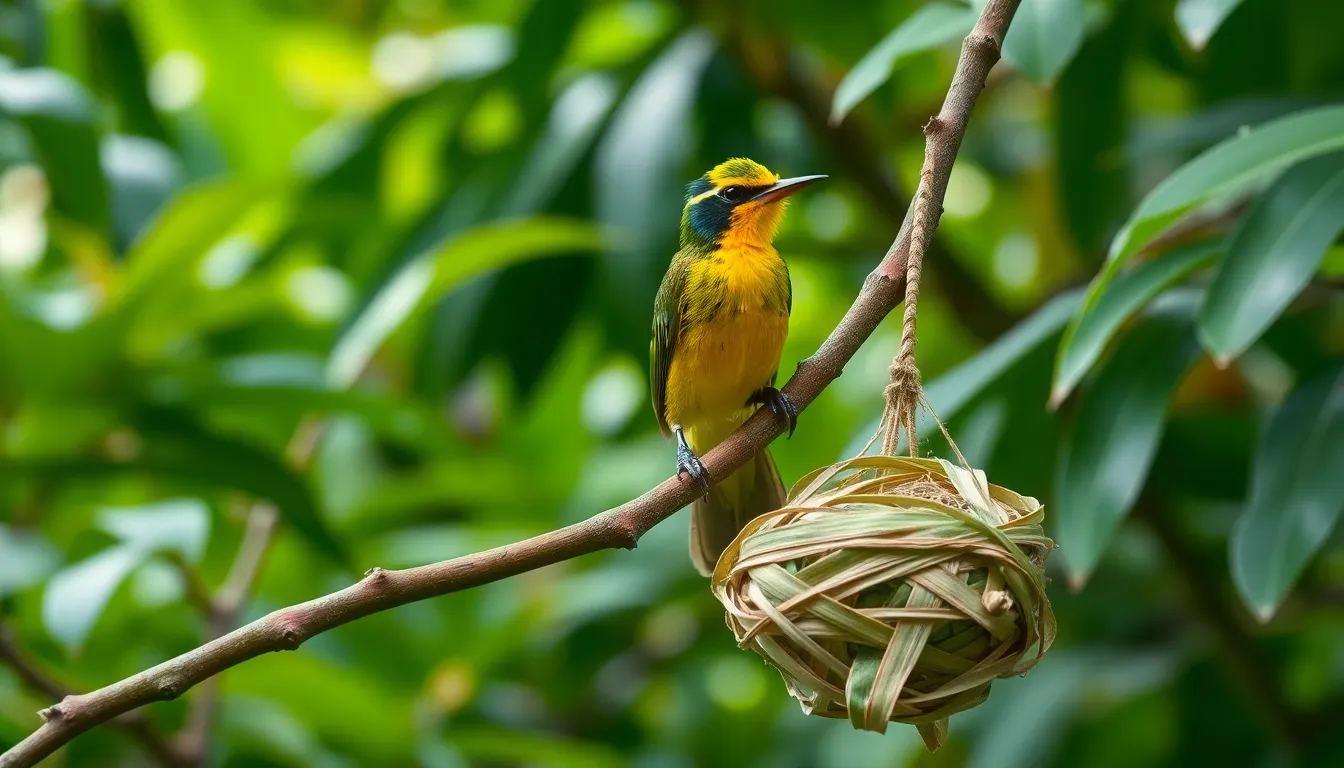
We currently observe stable populations for most tailor bird species across their natural ranges, though exact conservation assessments vary significantly among the 13 recognized species. The International Union for Conservation of Nature (IUCN) lists the Common Tailorbird as a species of “Least Concern” with an estimated global population exceeding 10 million individuals. Population trends remain stable across approximately 4.6 million square miles of suitable habitat, indicating resilient adaptation to environmental changes.
Regional species face more precarious situations than their widespread relatives. The Rufous-headed Tailorbird maintains a restricted range in the Philippines with fewer than 50,000 breeding pairs documented in recent surveys. Mountain tailorbird populations in Southeast Asian highlands experience declining numbers due to exact elevation requirements and limited dispersal capabilities.
Habitat destruction emerges as the primary threat to tailor bird populations throughout tropical Asia. Deforestation rates in Indonesia and Malaysia eliminate approximately 2.3 million acres of suitable nesting habitat annually, directly impacting species that require dense vegetation for leaf-sewing activities. Urban expansion reduces available nesting sites by converting natural areas into concrete landscapes lacking the flexible leaves essential for nest construction.
Climate change affects tailor bird breeding success through altered precipitation patterns and temperature fluctuations. Research indicates that rainfall changes impact the availability of suitable leaves, with drought conditions reducing leaf flexibility by up to 40% in tested samples. Temperature increases above 35°C during breeding season correlate with higher nest abandonment rates, particularly in urban environments where heat island effects intensify thermal stress.
Pesticide use in agricultural areas poses chemical threats to insectivorous tailor birds whose diet consists of 85% insects and small arthropods. Organophosphate concentrations in treated crop areas exceed safe levels for small songbirds, causing population declines of 15-25% in heavily farmed regions of India and Thailand. Bioaccumulation of these chemicals affects reproductive success and chick survival rates.
| Threat Category | Impact Level | Affected Species | Population Change |
|---|---|---|---|
| Habitat Loss | High | 8 of 13 species | -20% over 10 years |
| Climate Change | Moderate | All species | -5% breeding success |
| Pesticides | High | Agricultural populations | -25% in treated areas |
| Urban Expansion | Moderate | Common Tailorbird | Stable with adaptation |
Invasive plant species disrupt traditional nesting materials by replacing native vegetation with unsuitable alternatives. Introduction of non-native trees in urban parks creates environments where leaves lack the proper flexibility for effective sewing, forcing tailor birds to abandon territories they’ve occupied for generations. Exotic plants like eucalyptus and acacia don’t provide the structural properties required for successful nest construction.
Human disturbance during breeding season increases nest abandonment rates, particularly in areas with heavy foot traffic or construction activities. Studies show that consistent noise levels above 60 decibels within 20 meters of active nests result in 35% higher abandonment rates compared to quieter locations. Tourist activities in national parks create additional pressure on breeding populations.
Conservation efforts focus on habitat preservation and restoration programs across key breeding areas. Protected area management in countries like Thailand and Malaysia maintains crucial nesting habitats for endemic species while supporting research initiatives that monitor population trends and breeding success rates.
Observing Tailor Birds in the Wild
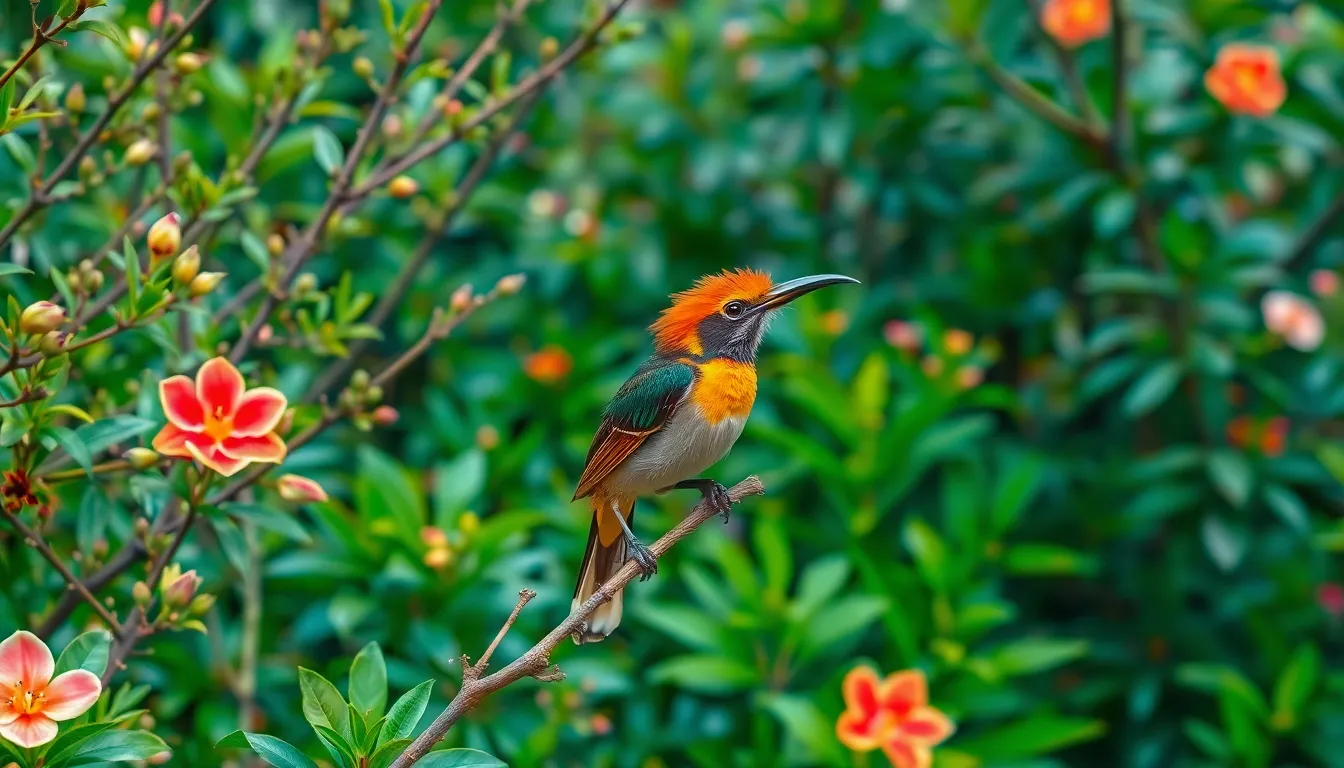
Spotting these master craftsmen in their natural habitat requires patience and knowledge of their preferred environments. We can maximize our chances of successful tailor bird encounters by understanding their behavioral patterns and identifying key characteristics in the field.
Best Locations for Birdwatching
Gardens with dense shrubs and flowering plants provide excellent tailor bird observation opportunities throughout tropical Asia. Urban parks featuring native vegetation attract Common Tailor Birds particularly in cities across India, Thailand, and Malaysia where populations exceed 50 pairs per square kilometer.
Forest edges offer prime viewing locations where tailor birds forage actively between 6 AM and 10 AM daily. We find the highest activity levels in areas containing:
- Mixed vegetation zones with both deciduous and evergreen plants
- Water sources like streams or ponds within 200 meters
- Minimal human disturbance during early morning hours
- Dense understory growth providing cover and nesting materials
Mountain regions between 500 to 1,500 meters elevation host Dark Necked Tailor Birds in countries like Nepal and Myanmar. Protected reserves such as Khao Yai National Park in Thailand and Silent Valley National Park in India maintain stable populations with documented breeding sites.
Coastal mangrove areas support specialized tailor bird populations adapting to saltwater environments. Malaysia’s mangrove forests record tailor bird densities of 12 to 18 breeding pairs per hectare during peak season from March to August.
Tips for Identification
Size comparison helps distinguish tailor birds from similar species as they measure 4 to 6 inches with distinctive proportions. We identify males by their bright rufous crowns during breeding season and longer tail feathers extending 2 to 3 centimeters beyond wing tips.
Beak shape serves as the primary identification feature with its sharp curved design resembling a sewing needle. Common Tailor Birds display olive green upperparts contrasting with whitish underparts while Dark Necked species show darker throat patches extending to the upper chest.
Behavioral cues provide reliable identification markers as tailor birds exhibit unique movement patterns while foraging. We observe their characteristic:
- Acrobatic feeding positions hanging upside down from branches
- Quick darting movements between leaves lasting 2 to 3 seconds
- Territorial calling from exposed perches every 15 to 20 minutes
- Tail flicking motions occurring 8 to 12 times per minute
Vocalizations distinguish species with Common Tailor Birds producing sharp “tuit tuit” calls repeated 4 to 6 times. Dark Necked Tailor Birds emit lower pitched warbling songs lasting 3 to 5 seconds with melodic variations between populations.
Nest location provides definitive species confirmation when we spot their sewn leaf structures. Active nests appear as tightly stitched leaf pouches positioned 1 to 3 meters above ground in dense vegetation clusters.
Conclusion
The tailor bird stands as one of nature’s most ingenious architects demonstrating that size doesn’t limit capability. We’ve explored how these remarkable small songbirds have mastered the art of sewing leaves together creating secure homes that showcase millions of years of evolutionary refinement.
From their widespread distribution across tropical Asia to their specialized beaks that function as natural needles we can appreciate the perfect adaptation these birds have achieved. Their ability to thrive in both wild forests and urban environments speaks to their incredible resilience and adaptability.
As we continue to study and observe these feathered engineers we’re reminded of the importance of protecting their habitats. The tailor bird’s story teaches us that innovation and creativity aren’t exclusive to humans – sometimes the most brilliant answers come from the smallest creatures in our natural industry.
Frequently Asked Questions
What are tailor birds and why are they called “tailor birds”?
Tailor birds are small songbirds from the warbler family found primarily in Asia. They’re called “tailor birds” because of their unique ability to literally sew leaves together using their sharp beaks as needles and plant fibers as thread to create concealed nests for their young.
How big are tailor birds and what do they look like?
Tailor birds measure 4 to 6 inches in length and weigh approximately 6 to 10 grams. They have long, sharp, slightly curved beaks that function as sewing needles. Males display vibrant plumage during breeding season, while females have more subdued coloring for camouflage purposes.
How many species of tailor birds exist?
There are 13 recognized species of tailor birds in the genus Orthotomus, which belongs to the family Cisticolidae containing around 160 species total. The Common Tailor Bird is the most widespread species, while others inhabit various regions across tropical Asia and parts of Africa.
Where do tailor birds live?
Tailor birds inhabit diverse tropical and subtropical environments, from dense rainforests to urban gardens. They thrive in areas with dense vegetation, including tropical forests, woodland edges, cultivated areas, and even urban parks where they can find suitable leaves for nest construction.
How do tailor birds build their nests?
Tailor birds use their sharp beaks to create 6 to 12 puncture holes along leaf edges, then thread plant fibers through these openings. Females tie knots to secure the seams. The entire sewing process takes 2 to 3 hours per leaf connection, creating a secure cup-shaped nest.
What materials do tailor birds use for nest construction?
Tailor birds select living leaves from host plants and gather threading materials like spider silk, cotton fibers, and plant threads within a 50-meter radius. The inner nest is lined with soft materials including feathers, moss, and fine plant matter for comfort and insulation.
What do tailor birds eat?
Tailor birds have a diet consisting of 85% insects and small arthropods, with the remaining 15% being small fruits and nectar. They forage systematically in dense vegetation, defending their feeding territories while searching for food in systematic patterns.
Are tailor birds endangered?
Most tailor bird species maintain stable populations. The Common Tailorbird is listed as “Least Concern” by the IUCN with over 10 million individuals globally. However, some regional species face threats from habitat destruction, deforestation, urban expansion, and climate change.
Where can I observe tailor birds in the wild?
The best locations for observing tailor birds include gardens with dense shrubs, urban parks, forest edges, and coastal mangrove areas. Look for areas with thick vegetation where they can find suitable leaves and materials for nest construction and foraging.
How can I identify tailor birds?
Key identification features include their small size (4-6 inches), long sharp curved beak, and distinctive vocalizations. Males have more vibrant plumage during breeding season, while females display subdued coloring. Their unique sewing behavior and leaf-sewn nests are also identifying characteristics.

